
cGMP Upgrade to Automated Cleaning
Understanding the Impact of Automated Cleaning in Pharmaceutical Equipment
Automating the cleaning of pharmaceutical equipment brings several benefits that may not be immediately apparent. Let’s explore how this upgrade can enhance your processes.
The Benefits of Automated Cleaning Systems
- Labor Efficiency – Automated cleaning optimizes labor utilization, ensuring that manpower is deployed where it adds the most value.
- Consistency Through Validated Process Recipes – Automated systems provide uniformity in cleaning processes, minimizing human error and ensuring compliance with validated cleaning recipes.
- Reduced Documentation and Potential Deviations – The automated system minimizes manual documentation and reduces the likelihood of deviations in cleaning procedures.
- Control of Critical Process Parameters – Programmable Logic Controllers (PLC) enable real-time monitoring of cleaning processes, with alarms to alert operators to any necessary interventions.
- Enhanced Safety – By automating the cleaning process, the risks associated with manual cleaning (exposure to residual product, slips, confined spaces, etc.) are significantly reduced.
Challenges of Automated Cleaning
While the benefits are clear, there are also challenges to consider when implementing automated cleaning systems:
Key Challenges to Address
- Safety During Operation – Automated equipment introduces its own safety concerns. Ensuring proper safety protocols and equipment functionality is critical.
- Ensuring Full Wash Solution Coverage – It is essential that the wash solution covers all product-contact areas, especially in systems like spray balls dedicated to formulation tanks.
- Preventing Contamination – Avoiding cross-contamination and residual product or cleaning agents requires careful recipe and system design.
- Facility Utility Constraints – Automated systems often place additional demands on facility utilities, such as water and energy, which must be carefully managed.
Recommendations for Implementing Automated Cleaning
Overcoming the challenges of automated cleaning is feasible with proper planning. Consider the following recommendations to ensure a successful upgrade:
Qualification and Safety Testing
- Ensure all safety features are fully functional by conducting rigorous testing of E-Stops, alarms, and relief systems.
- Engage Environmental Health and Safety (EHS) teams to review safety procedures and ensure compliance.
Coverage Verification with Riboflavin Testing
- Use Riboflavin spray testing to verify full coverage of wash devices. Modify equipment as needed to ensure thorough cleaning.
Recipe Adjustments to Minimize Contamination
- Fine-tune cleaning parameters such as temperature, conductivity, and flow rate to eliminate residual contaminants and microbial growth. Ensure equipment is designed with sanitary features like sloped piping and minimized dead legs.
Communicate Utility Usage
- Keep facilities informed of utility needs to prevent disruptions. Automated systems typically require water, detergents, and energy sources, and advanced planning ensures uninterrupted operations.
Contact cGMP Consulting today and schedule time with one of our experts about automated cleaning and other regulatory questions you may have.




